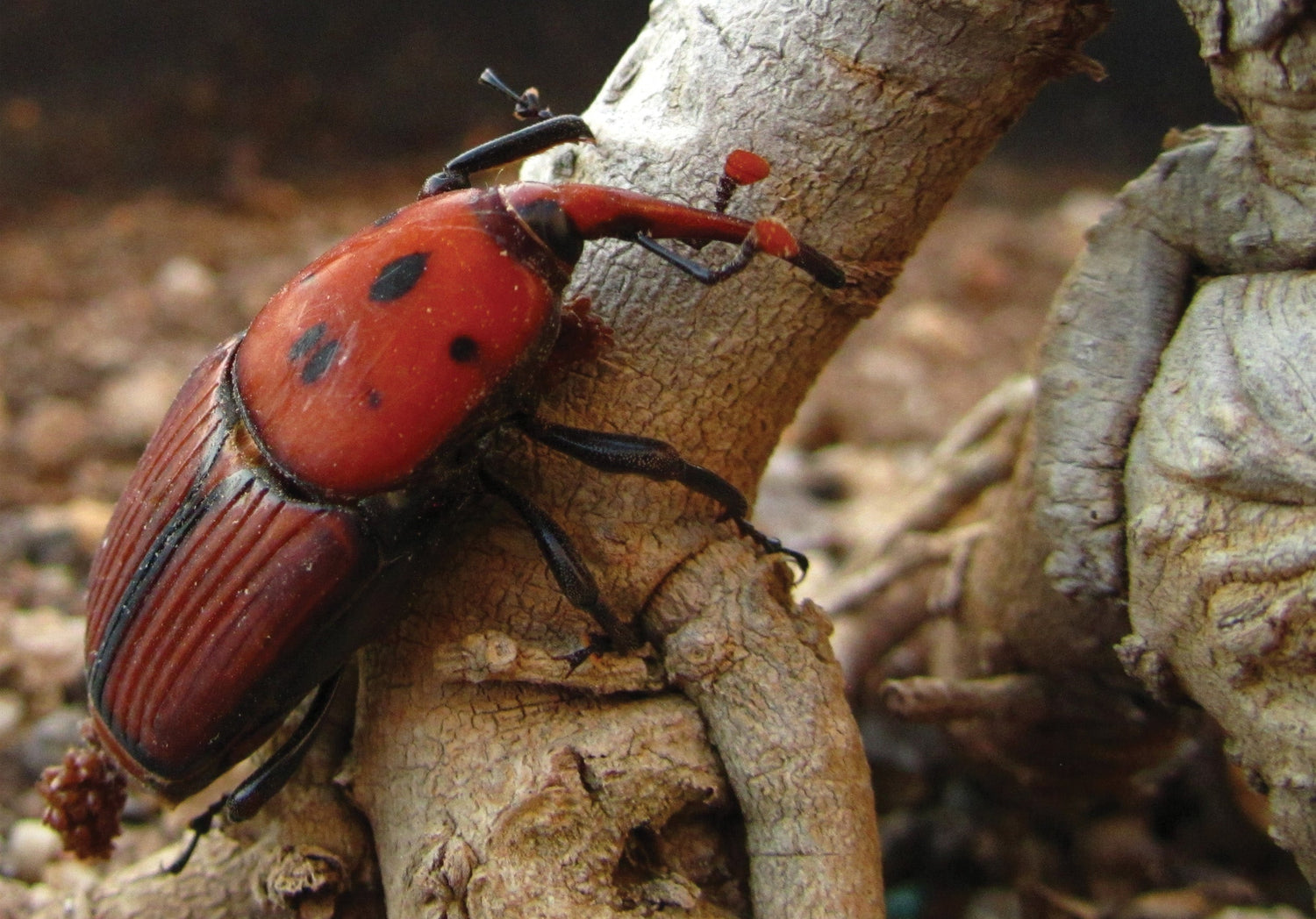Symptoms of Damage
The stem may exhibit holes with chewed-up fibers protruding out.Often, reddish-brown liquid can be seen oozing from these holes.The grubs cause damage inside the stem or crown by feeding on soft tissues, leading to severe damage, especially when a large number of them bore into the soft, growing parts. In severe infestations, the inside portion of the trunk can be completely eaten, becoming filled with rotting fibers.
In young palms, the top withers, while in older palms, the top portion of the trunk bends and ultimately breaks at the bend, causing wilting.
Sometimes, the gnawing sound produced by the feeding grubs inside can be audible.
In advanced stages of infestation, yellowing of the inner whorl of leaves occurs. The crown may fall down or dry up, leading to the death of the palm. 1.Holes on the stem
1.Holes on the stem
2.Chewed up fibres
Identification of the Pest
Egg: Oval and creamy white in colour. Eggs laid in scooped out small cavities, wounds and other cut injuries on the trunk
Grub: Light yellowish grub without legs. Stout, fleshy and apodous with a conical body bulged in middle and tapering towards the end
Pupa: The full frown larva pupates inside the stem and fibrous cocoon made out of fibrous strands
Adult: Reddish brown weevil has six dark spots on thorax. Male has conspicuous long snout has a tuft of hairs.
Management
Cultural Method
Remove and burn all wilting or damaged palms in coconut gardens to prevent further spread of the pest.
Avoid cutting green leaves. If necessary, cut them about 120 cm away from the stem to prevent the grubs from successfully entering through the cut end.
Chemical Method
In attacked palms, observe for boreholes and seal them, leaving only the topmost one open. Pour 1% carbaryl (20g per liter) or 0.2% trichlorphon at one liter per palm using a funnel through the topmost hole, then plug this hole as well. Repeat if necessary, after one week.
When the pest infestation is through the crown, clean the crown and slowly pour the insecticidal suspension. If the weevil enters through the trunk, plug the hole in the trunk with cement or tar. Create a slanting hole using an auger and pour the insecticide solution through a funnel.Fill the crown and the axils of the topmost three leaves with a mixture of fine sand and neem seed powder or neem seed kernel powder (2:1) once every three months to prevent damage from rhinoceros beetle attacks, during which the red palm weevil lays eggs.
Trap Method:
Coconut log traps
Set up attractant traps (mud pots) containing either 2½ kg of sugarcane molasses or 2½ liters of toddy (or pineapple or sugarcane activated with yeast or molasses), along with 5 ml of acetic acid, 5 g of yeast, and longitudinally split tender coconut stems or logs of green petioles of leaves (30 numbers per acre) to trap adult red palm weevils in large numbers.
Add insecticide to each trap to kill the weevils that are trapped.
 1.Pheromone lure with bucket
1.Pheromone lure with bucket
2.Trapped Red Palm Weevil
Pheremone trap
To set up the pheromone trap, begin by preparing specialized buckets with 3 or 4 holes, wrapped with coconut fiber or jute sack to allow pests to enter. Suspend the lure (Ferrolure +) inside the bucket and add 1 liter of water along with 100g of pineapple or sugarcane, 2g of yeast, and 2g of Carbaryl. Place these bait buckets at locations in the farm where infestation is most observed. After one week, check the water for trapped pests and refill the water to prevent mosquitoes from breeding.
